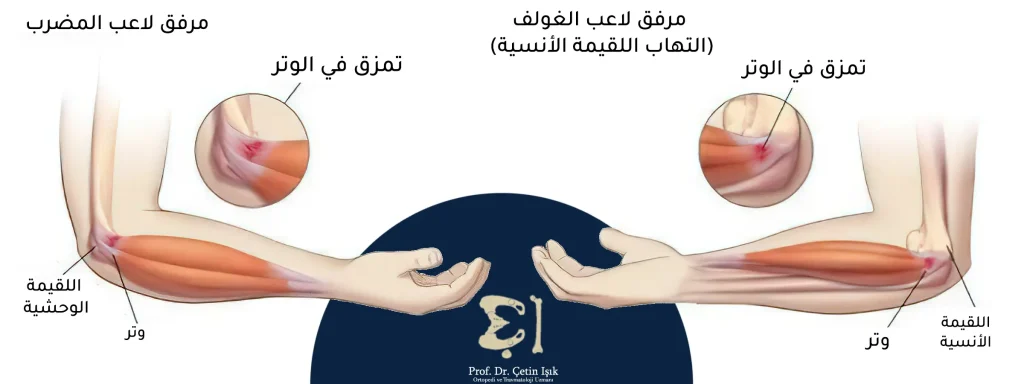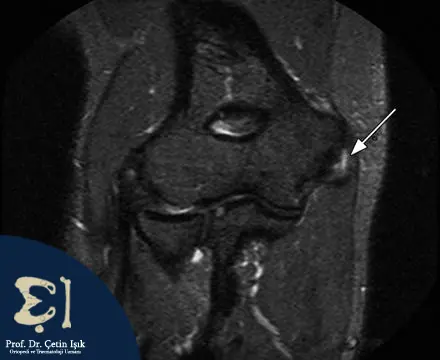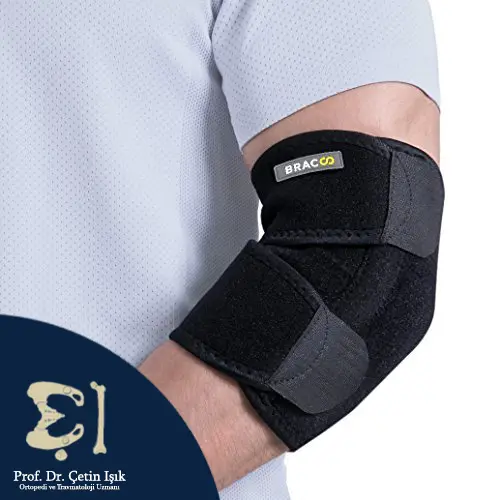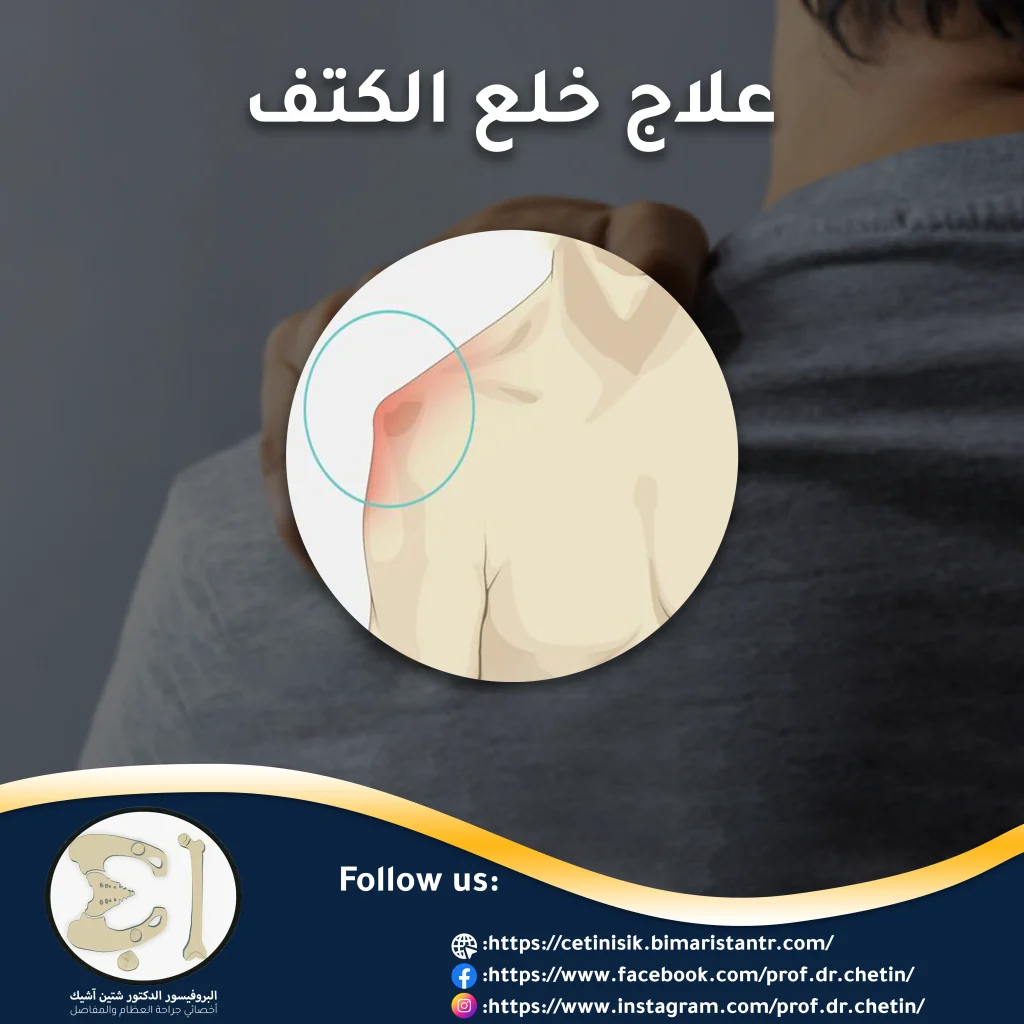Golfer's elbow is an inflammation of the tendons in the muscles that flex the wrist as a result of repetitive use, resulting in pain and discomfort that limits the patient's ability to bend their wrist.
Golfer's elbow is a condition that can improve on its own over time by avoiding the activities that caused it, but in some cases it may require surgery. Learn with us about golfer's elbow, its symptoms and treatment methods.
What is golfer's elbow?
Golfer's elbow is an inflammation of the tendons of the muscle that originates from the medial epicondyle of the humerus and bends the wrist toward the palm of the hand, resulting in pain along the medial (inner) aspect of the forearm.

Tendons are strong cords that connect muscles to bones. Inflammation in golf elbow occurs in the carpi flexor tendons, which arise from the medial epicondyle of the humerus.
Medial epicondylitis has been called golfer's elbow because of its frequent occurrence in golfers; But the disease can occur in sports and activities that require repeated use of the wrist flexors, such as baseball players and carrying a suitcase.
Golfer's elbow is similar to tennis elbow in terms of its mechanism of occurrence but differs in terms of the location of the pain, as golfer's elbow pain is on the inner side of the forearm; As for tennis elbow, it occurs on the outer side of the forearm due to inflammation of the tendons that arise at the expense of the lateral epicondyle of the humerus (external).

Causes of golfer's elbow
Golfer's elbow, or medial epicondylitis, occurs frequently in golfers as a result of damage to the muscles and tendons that flex the wrist due to repetitive use. However, there are other causes that can lead to medial epicondylitis, including:
- Playing tennis: Playing tennis usually leads to: Tennis player's elbow (Inflammation of the tendons of the extensor carpi muscles), but in some cases, repeatedly making inappropriate movements during exercise may lead to; Like the backhand of the ball; To inflammation of the wrist flexor tendons.
- Practicing sports that require frequent throwing: Practicing sports activities that require frequent throwing may lead to; Such as baseball and javelin throwing; Causes golfer's elbow.
- Carrying heavy weights: While lifting weights, you can make frequent movements of the wrist causing inflammation of the wrist flexor tendons.
- Some work that involves making repetitive hand movements, such as writing and carpentry.
Symptoms of golfer's elbow
Golfer's elbow can present with the following symptoms:
- Pain on the inner face of the elbow that radiates to the inner face of the forearm and is triggered when the wrist is bent
- Elbow stiffness due to swelling resulting from inflammation of the elbow and scar formation in its place
- Weakness of the hand due to damage and inflammation of the tendons
- Mild swelling and warmth in the elbow as a result of inflammation
- Numbness and tingling in the fingers (especially the little finger and ring finger)
Diagnosis of golfer's elbow
Golfer's elbow is usually diagnosed through the patient's clinical history, which includes playing golf or any activity that requires repetitive flexion of the wrist, in addition to a clinical examination in which the patient places his hand palm up on the table, and the doctor places his hand on the patient's hand and asks him to raise his hand through flexion. The wrist is against the resistance of the doctor's hand, causing pain.
Additional investigational methods can be performed to diagnose golfer's elbow, such as X-ray to rule out other causes that have the same symptoms, such as fractures and arthritis, and in rare cases, the doctor may request a magnetic resonance imaging (MRI) for a better and more comprehensive evaluation.

Golfer's elbow treatment
The patient must first stop playing golf or the activity that aggravates the symptoms, and then follow appropriate treatment methods that include:
- Apply an ice pack to the elbow to reduce inflammation and pain. You can also apply hot compresses to increase blood flow to the tendons and speed up their healing
- Take over-the-counter pain relievers such as nonsteroidal anti-inflammatory drugs (NSAIDs) to relieve elbow inflammation and pain.
- Wear a brace or splint to support the elbow and relieve pressure on the affected tendons, which helps them heal
- In some cases, corticosteroid (cortisone) injections are used to reduce inflammation and pain
- Physical therapy involves practicing strengthening exercises for the elbow muscles and tendons, and physical therapy techniques such as ultrasound may be used
- Extracorporeal shock wave therapy (ESWT) for chronic conditions that do not respond to other treatments
- Surgical treatment when previous treatment methods fail or in severe cases, which is done through open or laparoscopic surgery

Prevention of golfer's elbow
Avoiding excessive wrist flexion movements can be considered the most important factor in preventing golf elbow, in addition to following the following tips:
- Strengthening the forearm muscles by practicing exercises that increase the muscles’ ability to withstand muscle stress
- Warm up the muscles before engaging in sporting activity through simple stretching exercises
- Using appropriate tools during sporting activities (replacing heavy golf clubs with lighter graphite clubs)
- Avoid excessive use of the wrist and take a break if you feel any pain in the elbow
- Lift the weights correctly while keeping the wrist stable to reduce stress on the elbow
Golfer's elbow is a medical condition characterized by pain and discomfort on the inner side of the elbow and forearm due to inflammation of the medial epicondyl tendonitis as a result of playing golf. Most cases are self-limiting and heal on their own. Appropriate management methods can be used, such as analgesics, wearing braces, and even surgery.
Sources:
Common questions
Golf elbow is an inflammation of the medial epicondyl due to repetitive and excessive bending of the wrist when playing golf, resulting in pain that radiates over the inner part of the elbow and forearm.
Symptoms of golf elbow include pain that radiates to the inner side of the forearm and increases when the wrist is bent, elbow stiffness, hand weakness, mild swelling and warmth in the elbow, and numbness (tingles) in the fingers (especially the little finger and ring finger).
Golfer's elbow usually takes 6-18 months to heal.
Lying on your back and placing your arm straight at your side is the best resting position for golf elbow.




